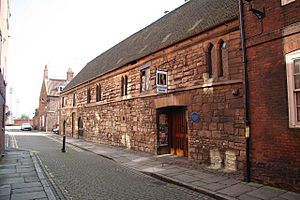Boston Friary facts for kids
A friary is a special kind of religious house where friars live. Friars are like monks, but they often travel and preach instead of staying in one place. The town of Boston in Lincolnshire, England, was once home to four different friaries. These were places where groups of friars lived, prayed, and worked many centuries ago.
The Augustinian Friary
52°58′18″N 0°01′09″W / 52.9717°N 0.0192°W The Augustinian Friary was started around 1317 or 1318. It was located near St John's Churchyard in an area called Skirbeck. The friars slowly bought more land over the years to build their friary. For example, they bought land in 1318, 1327, and 1342. In 1328, there were about twenty friars living here.
However, in 1539, the friary was closed down by the King during a time called the Dissolution of the Monasteries. This was when many religious houses in England were shut. The land was then rented out and later bought by the town of Boston. Today, much of the old friary site is covered by a building that used to be a workhouse.
The Carmelite Friary
First Friary 52°58′31″N 0°01′36″W / 52.9752°N 0.0266°W Later Friary 52°58′31″N 0°01′32″W / 52.9753°N 0.0256°W The Carmelites were also known as the White Friars because of the color of their robes. They first came to Boston in 1293 and settled in Skirbeck. Later, they moved to a new spot off High Street. They bought this land in 1308 and even got permission from King Edward II to build a church there.
The Carmelites continued to get more land in the following years, including gifts from important people like Simon Lambert and Sir John de Orreby. Like the other friaries, the Carmelite Friary was closed around 1544 or 1545 during the Dissolution of the Monasteries. After it closed, the town of Boston bought the land.
The Dominican Friary
52°58′32″N 0°01′22″W / 52.9756°N 0.0227°W The Dominicans were often called the Black Friars because of their dark robes. Their friary in Boston was founded quite early, in 1222. In 1288, their buildings, along with a large part of Boston, were burned in a big fire during a fair. The King even gave them eight oak trees from Sherwood Forest in 1290 to help them rebuild!
In 1327, the friars received special permission from the King to build an aqueduct. This was like an underground water pipe that brought fresh water all the way from Old Bolingbroke to their friary.
The Dominican friary was also forced to close in 1539 during the Dissolution of the Monasteries. The land was then taken by the King and given to the Duke of Suffolk. The good news is that one part of this friary, the refectory (which was the dining hall), is still standing today! It's a very old and important building, and it's now used as the Blackfriars Arts Centre.
The Franciscan Friary
52°58′29″N 0°01′18″W / 52.9748°N 0.0217°W The Franciscans were known as the Grey Friars. We don't know exactly when their friary was started, but it was before 1268. According to an old historian named Leland, the Franciscans in Boston often met with Esterlings, who were merchants from other European countries. Many of these merchants were even buried at the friary.
One famous person buried there was Wisselus de Smallenburg, a merchant from Munster who died in 1340. His grave slab (a stone marking his grave) can still be seen today in St Botolph's Church, Boston.
This friary was also taken over by the King in 1539. At first, the King kept the land for himself, but then he sold it to the town of Boston around 1544 or 1545, just like some of the other friary sites.


